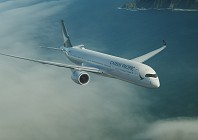Cathay Pacific flight CX731 to Dubai prepares for boarding – ‘gate closing’ flashes on screen as I sit in the first class Pier lounge sipping my orange juice, gently reclined and reading about the latest Hollywood scandal. The gate is only a five-minute walk from the lounge, so I figure I have a little while before I need to rush.
I walk straight onto the plane after being greeted by the very friendly cabin crew, jump into my chair and immediately check out the business class functions. There’s a lie-flat bed for starters, massage function and amenities kit complete with socks, eye mask, lip balm, hand and face cream, and a toothbrush with toothpaste.
Each of the seats is extremely private – they lie diagonally with a screen separating each seat from the one in front and behind, so passengers with window seats face inwards toward the front of the plane. The configuration makes looking out the window something of a challenge, but since it was night I had no complaints. The airline has done away with the old scratchy blankets and instead offers a soft, cosy duvet.
I’m not a huge fan of flying but there is something about spending eight hours in the air that appeals to me: there’s no internet (for now…), no mobile, just a huge array of movies, a delicious menu to choose from and a rather comfy bed.
I begin looking at the in-flight magazine, aptly named Discovery, and learn that Cathay Pacific has a rich history behind its modern facade. The journey began in the mid 1900s; the brainchild of entrepreneurs Roy Farrell and Sydney de Kantzow. The two gentlemen had a vision that one day China would be connected to the world. They wanted to fly both passengers and cargo out of Shanghai. In 1946 they moved this dream to Hong Kong and started Cathay (an old name for China) Pacific, as they hoped the airline would one day fly across it.
The first two planes Cathay Pacific acquired were old US Army surplus DC3s named Betsy and Nikki. The two planes began passenger services from Hong Kong to Rangoon, Singapore, Manila and Macau. Betsy’s first flight was in February 1946, when she carried clothes from Sydney to Shanghai. By 1948 Cathay owned a fleet of seven planes. Later that year, following the great success of the airline, regional aviation giants Butterfield & Swire acquired a majority shareholding and Cathay Pacific continued to grow.
It was under the watchful eye of Butterfield & Swire’s then-owner JK Swire that Cathay entered a period of rapid development. In 1949 he bought the company’s first four-engine aircraft, and 10 years later, Cathay was flying as far as Japan and Australia. The expansion continued over the next few decades, firmly putting Cathay Pacific on the map as a world-class carrier. It was first to launch the Boeing 777-300 – the world’s largest twin-engine commercial aircraft – in 1998, and continued to cement its position in the region by completing its acquisition of Dragonair in 2006. Today Cathay is one of the world’s most recognised airlines for its commitment to service, offering frequent flights to 162 destinations worldwide, with its main hub based in bustling Hong Kong.
But what of Cathay’s first ever plane? Amid the expansion programme, in 1950 poor Betsy was no longer deemed useful and was replaced with a newer, younger model. But like all great stories there is of course a happy ending. In the late 1980s, Betsy was found carrying cargo around Australia and brought back to her rightful home. She now sits in pride of place in the Hong Kong Science Museum, after being restored to her former 1940s glory. As I finish reading, the lights go out in the cabin and I settle down for the night. Eight hours later I awaken to the bright lights of Dubai, ready to face the world.

IMPORTANT BIT
What: Cathay Pacific Business Class
Cost: Return business class flight from Dubai-Hong Kong starts at AED 5,020 (US$1,366).
www.cathaypacific.com










